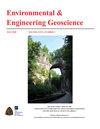剪切速率对土体抗剪强度的影响
IF 1
4区 工程技术
Q4 ENGINEERING, ENVIRONMENTAL
引用次数: 0
摘要
最重要的力学性能之一是抗剪强度。它取决于土体在破坏前所能承受的最大剪应力值。超过抗剪强度会导致一个颗粒紧挨着另一个颗粒滑动,导致土的破坏。有效应力作用下土体的抗剪强度1为排水强度参数:内摩擦角(φ)和黏聚力(c)的组合,由莫尔-库仑破坏准则定义。它是通过“现场”和实验室实验确定的。直接剪切法是测定土体抗剪强度最古老、最简单的室内试验方法。实验的第一阶段是试样在特定垂直应力下的固结,在第二阶段,根据土壤的固结特性,试样以给定的剪切速率剪切。无黏性土的剪切速率比黏性土高100倍。剪切速率和排水条件影响土体强度参数的大小。对比论证了不同剪切速率对直剪装置峰值抗剪强度和残余抗剪强度的影响。试验采用两种低塑性粘土(CL)和一种高塑性粘土(CH)进行。本文章由计算机程序翻译,如有差异,请以英文原文为准。
Influence of
shear rate on the soil's shear strength
One of the most important mechanical properties is shear strength. It is conditioned by the value of the maximum shear stress that the soil can withstand before failure. Exceeding the shear strength causes one particle to slide next to another, causing the failure of soil. The shear strength of the soil for effective stresses is1 a combination of drained strength parameters: internal friction angle (φ) and cohesion (c) defined by the Mohr-Coulomb failure criterion. It is determined “in situ” and by laboratory experiments. Direct shear is the oldest and the simplest laboratory experiment to determine the shear strength of the soil. The first phase of experiment is specimen consolidation under specific vertical stress, and in the second phase specimens are sheared at a given shear rate, depending on the consolidation properties of the soil. Cohesionless soils are sheared at up to 100 times higher shear rate compared to cohesive soils. Shear rate and drainage conditions affect the magnitude of soil strength parameters. The paper is based on the comparison and demonstration of the influence of different shear rates on the peak and residual shear strength in the direct shear device. The tests were performed on two samples of low plasticity clay (CL) and one sample of high plasticity clay (CH).
求助全文
通过发布文献求助,成功后即可免费获取论文全文。
去求助
来源期刊

Environmental & Engineering Geoscience
地学-地球科学综合
CiteScore
2.10
自引率
0.00%
发文量
25
审稿时长
>12 weeks
期刊介绍:
The Environmental & Engineering Geoscience Journal publishes peer-reviewed manuscripts that address issues relating to the interaction of people with hydrologic and geologic systems. Theoretical and applied contributions are appropriate, and the primary criteria for acceptance are scientific and technical merit.
 求助内容:
求助内容: 应助结果提醒方式:
应助结果提醒方式:


